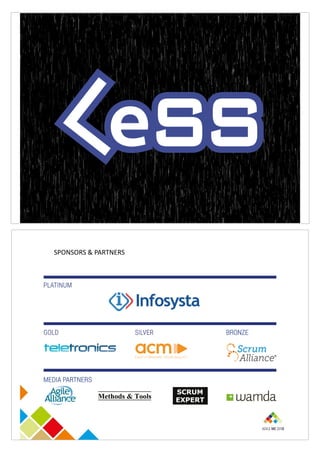Story of LeSS by Bas Vodde
This talk is based on story-telling, where Bas will share the creation of LeSS and within that side-track on explaining better how LeSS works. Expect most of the session to be in story format and not in typical introduction to X format. LeSS is a lightweight (agile) framework for scaling Scrum to more than one team. It was extracted out of the experiences of Bas Vodde and Craig Larman while Scaling Agile development in many different types of companies, products and industries over the last ten years. There are several case studies available and an book describing LeSS in detail. LeSS consists of the LeSS Principles, the Framework, the Guides and a set of experiments. The LeSS framework is divided into two frameworks: basic LeSS for 2-8 teams and LeSS Huge for 8+ teams. All of these are also available on the less.works website. LeSS is different with other scaling frameworks in the sense that it provides a very minimalistic framework that enables empiricism on a large-scale which enables the teams and organization to inspect-adapt their implementation based on their experiences and context. LeSS is based on the idea that providing too much rules, roles, artifacts and asking the organization to tailor it down is a fundamentally flawed approach and instead scaling frameworks should be minimalistic and allowing organizations to fill them in. Learning Outcomes: - See why experimenting is a key to improvement - Learning the difference between component and feature teams. - Understanding the difficult problem of owning vs renting processes - Understand the LeSS Frameworks and the LeSS 'complete' picture - Seeing why organizational complexity - added roles, processes and artifact - is harmful for agility.

Empfohlen
Weitere ähnliche Inhalte
Was ist angesagt?
Was ist angesagt? (20)
Ähnlich wie Story of LeSS by Bas Vodde
Ähnlich wie Story of LeSS by Bas Vodde (20)
Mehr von Agile ME
Mehr von Agile ME (20)
Kürzlich hochgeladen
Kürzlich hochgeladen (15)
Story of LeSS by Bas Vodde
- 2. Sprint Sprint Planning Planning Part 1 Part 2 (2-4 h) (2-4 h) Product Owner Product Backlog Daily Scrum (15 min) 1 day 2-4week Sprint Sprint Sprint Retro- Review spective (Feature) Team + Product Backlog ScrumMaster Refinement (5-10% of Sprint) Potentially Shippable Product Increment Sprint Backlog www.craiglarman.com www.odd-e.com Copyright © C.Larman & B. Vodde 2009. All rights reserved. Sprint Sprint Planning Planning Part 1 Part 2 (2-4 h) (2-4 h) Product Owner Product Backlog Daily Scrum (15 min) 1 day 2-4 week Sprint (Feature) Team + Product Backlog ScrumMaster Refinement (5-10% of Sprint) Sprint Backlog Potentially Shippable Product Increment Sprint Sprint Retro- Review spective (2-4 h) (1.5-3h) www.craiglarman.com www.odd-e.com Copyright © C.Larman & B. Vodde 2009. All rights reserved.
- 3. Architect Dev. Team 1 Test Team 2 Team 3 Product Service & Support Product Owner Team Require- ment Area Require- ment Area Undone Organ- ization Scrum Feature Team Scrum Feature Team Scrum Feature Team Product Test System Test Architect ure Develop ment Develop ment Dev Team1 Dev Team3 Dev Team2
- 5. Story - Nick
- 10. LeSS Books Scaling Lean & Agile Development Thinking and Organizational Tools for Large-Scale Scrum Craig Larman Bas Vodde
- 11. Shu Ha Ri Prescription or Ownership?
- 12. LeSS Rules “Kent cates read.” — Eric is a master at creating code that communi- well, is easy to understand, and is a pleasure to hGamma, IBM Distinguished Engineer Craig Larman Bas Vodde TheAddison-WesleySignatureSeries Large-Scale Scrum More with LeSS with Illustrations by Sketch Post
- 13. LeSS Guides
- 14. LeSS is...
- 15. More with Less Build Your Method Up - Don’t Tailor It Down
